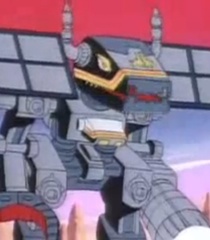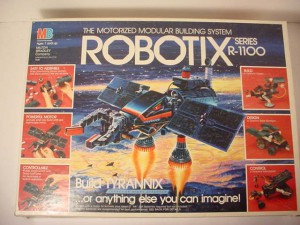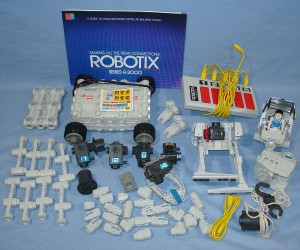Powet Alphabet: R is for Robotix
by Crazy, filed in Articles, Powet Alphabet on May.06, 2011
Who puts the future in your hands? Robotix! Robotix!
As a child of about 5 or 6 and later, my mother would often take my sister and I to the local The Video Store. That is capitalized because, as I recall, that was the actual name of the business. Local businesses renting vhs tapes of movies and television was the norm back then, long before national chains like Blockbuster Video moved in and undercut them and even longer before Netflix would establish itself undercutting the national chains and let us not mention YouTube or Hulu just yet. Going to The Video Store was quite the treat. My mother would allow us to rent one or two videos of our choice. It would not be out of the norm for me to rent a couple episodes of The Transformers or Challenge of the Go-Bots. That was my proverbial jam in those days and, truthfully, still is. There was one movie in that children’s section that I really adored and rented many many times that was neither Transformers, Go-Bots, nor any other wildly popular franchise at the time (and there were a lot of them). This 90 minute movie was called Robotix. And that is why today is R for Robotix.
Super Sunday 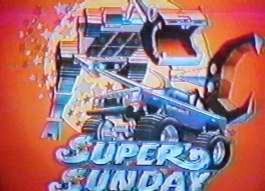
I did not know it at the time, but Robotix was not originally a movie. It was actually a television series that consisted of 15 six minute episodes. It aired on Super Sunday, a 30 minute block of children’s programming featuring shows of varying lengths by Sunbow and Marvel Productions. All of the shows featured Hasbro properties. The Super Sunday line-up consisted of Big Foot and the Muscle Machines, Jem and the Holograms, Robotix and Inhumanoids.  Two to three of these shows would air in a given episode of the block. Only Jem and the Inhumanoids would go on to get their own full series, with Jem going on to become the most popular. Each of the four series would see their episodes bundled together into a movie for a vhs tape release which is the form that I was introduced.
Two to three of these shows would air in a given episode of the block. Only Jem and the Inhumanoids would go on to get their own full series, with Jem going on to become the most popular. Each of the four series would see their episodes bundled together into a movie for a vhs tape release which is the form that I was introduced.
In 2003, the series would be released on DVD for Region 2 in the UK and Ireland.
Premise
The premise of the show finds a group of humans stranded on an alien planet. The planet, seemingly uninhabited, turns out to be home to two factions of giant robots at war with each other. The protagonists are called the Protectons, while the antagonists are labeled the Terrakors. They continually battle over a supercomputer called Compucore. Both the Protectons and Terrakors were once biological lifeforms, but were forced into stasis due to poor planetary conditions. Eventually some of their essences were transfered to the large robotic forms of the Robotix and their war broke out anew.
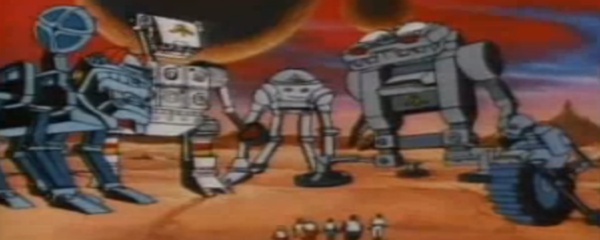
When the humans piloted the Robotix, they were capable of transforming into different forms or activating previously hidden weapons. Some of the transformations just make no sense as can be seen when Argus, leader of the Protectons is fighting Nemesis, leader of the Terrakors. At one point, Nemesis is overwhelming Argus, but then a human jumps in his cockpit and the following transformation consists of Argus folding his legs up to his shoulders for no apparent reason, then just ramming Nemesis with his head.
One of the things that really struck me about the Robotix was that none of them are remotely similar to each other. They are all unique forms. Some are bipedal, some are quadrupedal, while others travel on tank treads or wheels. Some even fly. This makes for great characterization and development and would have really propelled sales of a toy line. (We’ll talk toys later.)
Playlist of all 15 episodes (1 hour 30 minutes)
Comic Book
 The series also earned itself a Marvel comic book tie-in. The book roughly followed the story of the first three episodes and consisted of only a single issue.
The series also earned itself a Marvel comic book tie-in. The book roughly followed the story of the first three episodes and consisted of only a single issue.
Similarities to other Hasbro Properties
Voice Cast
The voice cast of Robotix uses many familiar names we know from other Hasbro series such as Transformers and GI Joe. In fact, both Transformers and Robotix shared the same voice director in Wally Burr. Some of the other voice cast for Robotix include:
Michael Bell – Lupus, Kontor, Traxis, Venturak
– TF credits: Prowl, Bombshell, Scrapper, Sideswipe, Swoop, etc
– GI Joe: Duke, Blowtorch, Scrap-Iron, Clutch, Lift-Ticket, Tollbooth, Major Bludd, Xamot
Arthur Burghardt – Argus, Boltar, Steth
– TF credits: Devastator
– GI Joe: Destro, Iceberg, Stalker
Corey Burton – Goon, Kanawk, Tauron
– TF credits: Young Alpha Trion, Brawn, Dion, Shockwave, Spike Witwicky, Sunstreaker, Vector Sigma
Victor Caroli – Narrator
– TF credits: Narrator
Peter Cullen – Nemesis, Spiro
– TF credits: Optimus Prime, Ironhide, Slugslinger, Streetwise, Nightstick, etc
– GI Joe: Airborne, Zandar, Nemesis Enforcer
Pat Fraley – Exeter Galaxon, Nomo
– GI Joe: Ace, Barbecue
Jason Naylor – Zarru
Neil Ross – Flexor, Gaxon, Jerrock
– TF credits: Bonecrusher, Crosshairs, Fracas, Hook, Monzo, Pointblank, Sixshot, Slag, Springer
– GI Joe: Dusty, Shipwreck, Buzzer, Monkeywrench, Heavy Metal
Susan Silo – Compucore, Narra
Frank Welker – Bront, Terragar, Tyrannix
– TF credits: Blades, Buzzsaw, Chromedome, Frenzy, Galvatron (after the movie), Groove, Laserbeak, Megatron, Mirage, Mixmaster, Ratbat, Ravage, Rumble, Sharkticon, Skywarp, Sludge, Soundwave, Steeljaw, Trailbreaker, Wheelie, etc
– GI Joe: Wild Bill, Polly, Junkyard, Torch, etc
Nemesis’ seemingly main lieutenant, Tyrannix, is ambitious and attempts to overthrow Nemesis at one point in the story much like Starscream repeatedly attempted in Transformers. His voice was also one of the more unique in the series. In addition, Tyrannix was the only flyer.
Toys
The toys for Robotix were released under Milton Bradley, a division of Hasbro since 1984. Unfortunately, the toys were the weakest part of the franchise. Not necessarily because they were of poor quality, but rather they did not really reflect the fiction that they had established to support it. The toy line for Robotix was more of a modular construction set in the vein of Construx or Erector sets. While the sets featured character names on them from the show, the box art did not reflect the character’s robotic form. Tyrannix, for example, was of a bipedal upright humanoid form with a solar array on either side of his head, while the box art displayed a space ship made of the same parts, but no where on the box did the robotic form from the show appear.
The humanoid figures that came with the construction sets were also not the same characters from the show, but, instead, were generic space pilots. Probably, the biggest problem with the sets was that they were marketed toward young children, yet the sets were complex and contained dozens of parts that no parent wanted to deal with or put together. The fiction and marketing of the products were just aimed at too young of a target demographic.
Jayce and the Wheeled Warriors was a series that had almost the same problems as Robotix, in that the toy line was a modular system of play with many parts, but Robotix was guilty to such an extended degree that it really had no hope from the start. Robotix would make an excellent case study for any marketing class.
Commercial 1
Commercial 2
Robotix was a series that had enormous potential in several respects. In fact, it tried to take advantage of too many of them and failed at all of them. The Robotix toy line stuck around until around 2003 as mainly a hobby set for young adults in middle and high school. The fiction from the movie was lacking very little that many other wildly popular franchises featured at the time and given a proper toy line of action figures along the lines of simple Transformers, really had nothing to hold it back. The modular construction sets could have been introduced at a later time as the target demographic got older to keep them interested with more complex play patterns. While the series was created to sell the toys, its unfortunate the toys weren’t created to sell the series.
Do you remember Robotix? Did you watch the series embedded above? Tell us what you thought in the comments!


 PS3
PS3
 Famicom Dojo
Famicom Dojo KEEP PLAYING
KEEP PLAYING KEEP PLAYING: Rewind
KEEP PLAYING: Rewind Powet Toys
Powet Toys Powetcast
Powetcast Hitchhiker's Guide POWETcast
Hitchhiker's Guide POWETcast















